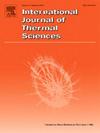Experimental and numerical investigation of the frictional performance of the single-phase flow through a dimple plate heat exchanger
IF 4.9
2区 工程技术
Q1 ENGINEERING, MECHANICAL
International Journal of Thermal Sciences
Pub Date : 2025-06-16
DOI:10.1016/j.ijthermalsci.2025.110081
引用次数: 0
Abstract
In this study, experimental testing and numerical simulations were conducted to investigate the effects of different structural parameters on the flow resistance of dimpled plate heat exchangers. The experimental tests covered three plate configurations, each comprising 30 plates, 14 primary channels, and 15 secondary channels under the conditions of inlet hot- and cold-water temperatures of 70 and 50 °C. The water mass flux varied from 8 to 500 kg m−2 s−1, corresponding to Reynolds numbers of 100–3000. The results showed that the D3-type plate heat exchangers exhibited the lowest flow resistance, whereas the D1-type exhibited the highest resistance. Numerical simulations were performed using a three-channel counterflow arrangement (hot-cold-hot) to validate the accuracy of the numerical model. Simulations were performed for dimpled plates with five dimple depths (0.7–1.5 mm) and five dimple pitches (2.8–6 mm). The results indicated that the pressure drop decreased with increasing dimple depth and pitch, while the friction factor increased with γ (the ratio of the pressing depth to pitch). The flow within the plates transitioned from laminar to turbulent at a Reynolds number of approximately 300. A new friction factor correlation suitable for cases involving single structural parameter variations with an absolute mean deviation of approximately 4.9 % was proposed.
多孔板换热器单相流动摩擦特性的实验与数值研究
本文通过实验测试和数值模拟研究了不同结构参数对压窝板式换热器流动阻力的影响。在进口热水和冷水温度分别为70°C和50°C的条件下,实验测试了三种板形结构,每种板形结构包括30个板形、14个主通道和15个次通道。水质量通量在8 ~ 500 kg m−2 s−1之间变化,对应的雷诺数为100 ~ 3000。结果表明:3型板式换热器的流动阻力最小,d1型板式换热器的流动阻力最大;采用三通道逆流布置(热-冷-热)进行了数值模拟,验证了数值模型的准确性。模拟了5个凹痕深度(0.7 ~ 1.5 mm)和5个凹痕间距(2.8 ~ 6 mm)的凹痕板。结果表明:压降随压痕深度和节距的增加而减小,摩擦系数随压痕深度与节距之比γ的增加而增大;当雷诺数约为300时,板内流动由层流转变为湍流。提出了一种新的摩擦系数相关性,适用于结构参数单一变化的情况,其绝对平均偏差约为4.9%。
本文章由计算机程序翻译,如有差异,请以英文原文为准。
求助全文
约1分钟内获得全文
求助全文
来源期刊

International Journal of Thermal Sciences
工程技术-工程:机械
CiteScore
8.10
自引率
11.10%
发文量
531
审稿时长
55 days
期刊介绍:
The International Journal of Thermal Sciences is a journal devoted to the publication of fundamental studies on the physics of transfer processes in general, with an emphasis on thermal aspects and also applied research on various processes, energy systems and the environment. Articles are published in English and French, and are subject to peer review.
The fundamental subjects considered within the scope of the journal are:
* Heat and relevant mass transfer at all scales (nano, micro and macro) and in all types of material (heterogeneous, composites, biological,...) and fluid flow
* Forced, natural or mixed convection in reactive or non-reactive media
* Single or multi–phase fluid flow with or without phase change
* Near–and far–field radiative heat transfer
* Combined modes of heat transfer in complex systems (for example, plasmas, biological, geological,...)
* Multiscale modelling
The applied research topics include:
* Heat exchangers, heat pipes, cooling processes
* Transport phenomena taking place in industrial processes (chemical, food and agricultural, metallurgical, space and aeronautical, automobile industries)
* Nano–and micro–technology for energy, space, biosystems and devices
* Heat transport analysis in advanced systems
* Impact of energy–related processes on environment, and emerging energy systems
The study of thermophysical properties of materials and fluids, thermal measurement techniques, inverse methods, and the developments of experimental methods are within the scope of the International Journal of Thermal Sciences which also covers the modelling, and numerical methods applied to thermal transfer.
 求助内容:
求助内容: 应助结果提醒方式:
应助结果提醒方式:


